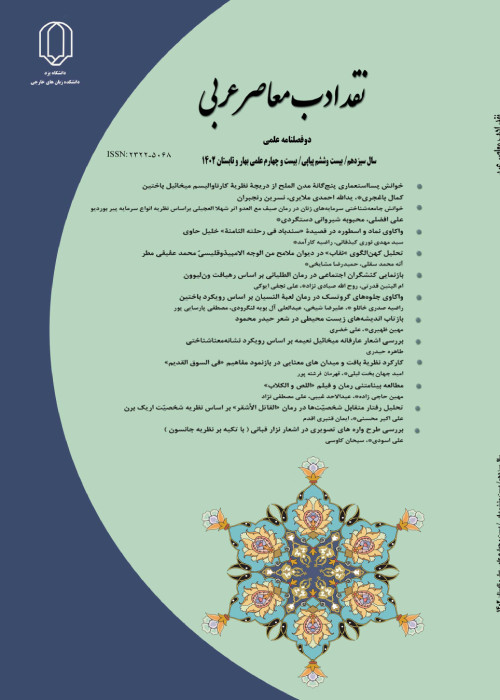Semiotic layer of time in the play "Al-Osfour Al-Ahdab" by Mohammad Al-maghout
Layered semiotics is one of the new approaches in the field of linguistics. This approach provides the basis for extensive analysis of literary texts in the context of interactive relationships between sign systems and text layers. The approach in question seeks to provide a detailed analysis of the text with its cryptographic, linguistic, speech, and contextual infrastructures. In a model of layered semiotics, textual levels are created by the spoken features of symbols in the form of codes, and each symbol is transformed into a text as interactive discourse. This study seeks to answer the following questions:How are the codes of time related to the other levels of signaling?What are the special features and structural components of these codes in the play in question? The findings of the research indicate that the play "Al-Osfour Al-Ahdab" is an organized cryptographic system composed of several layers such as time, place, conflict and scene. There is a close semantic correlation among the layers that has led to the formation of textual implications and the creation of various secondary meanings in the play. The secondary meanings of this text always refer to political and economic issues.
This study is based on the theory of layered semiotics and the role of time in the production of meaning and the conveyance of the latent concepts in the play "Al-Osfour Al-Ahdab". It explains how to organize time elements and their interaction with layers of staging, characterization, struggle and place in the play.
As the results show, time is one of the most important layers of signs without which the other levels can never be realized. The system of time in the play "Al-Osfour Al-Ahdab" has several levels of cryptography such as circular, linear and emotional levels. In the work in question, the circular layer has a wide range of functions. Using this layer, the author creates secondary meanings that are related to the social situation in Arab countries, such as injustice, oppression of rulers, poverty of the lower classes of society and political suffocation. Linear and emotional levels are sparsely seen in the text of the play and have a more limited function than the circular layer.There is a reciprocal relationship between the time element and the other layers. Sometimes the relationship between time and the discussed layers occurs in the context of companionship by means of certain textual components and sometimes in the context of substitution achieved by deleting the mentioned components. In fact, understanding time as a semiotic process is possible by considering the other textual levels such as scene, character, conflict and place. On the one hand, time plays an important role in advancing the scene, character, conflict and place. On the other hand, these levels are effective in organizing and selecting the time system.
The connection of time with the stage often occurs through elements such as decor, sound and light. In the design of the decor, the employed natural elements indicate the freezing of time and drought. The use of tools that indicate wear and tear also shows the relationship between time and decor. At the audio level, the connection between the two layers is expressed through environmental and musical elements. In this regard, it can be said that, in the play Al-Osfour Al-Ahdab, environmental sounds have a significant frequency. They refer to time more than musical elements. In fact, the connection between sound and time in the play always promises the end of the authoritarian rule. The codes of light often depict the night, and the black and gray spaces show the suffocating situation of in Arab countries in the present era. The connection between time and characterization, which is made through external layers such as age, clothing and personal belongings as well as the inner layer, which includes moods and emotions like weakness of will and self-destruction. Time is often directly or explicitly related to the outer layers and indirectly to the inner layers. The layer in question mainly serves to create the speech, behavioral and ideological contradictions of the characters in this play. Political, economic and social crises are the main issues that cause the interaction between time and conflict. The connection of the time and place elements is often explicit and occurs in the context of companionship. This solidarity is created in open and closed places such as city, village, shop and house.
- حق عضویت دریافتی صرف حمایت از نشریات عضو و نگهداری، تکمیل و توسعه مگیران میشود.
- پرداخت حق اشتراک و دانلود مقالات اجازه بازنشر آن در سایر رسانههای چاپی و دیجیتال را به کاربر نمیدهد.



